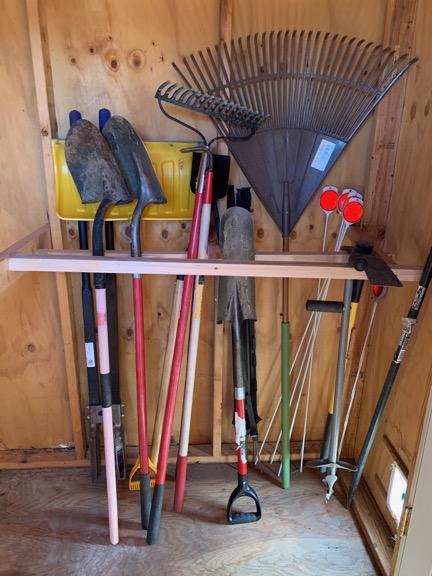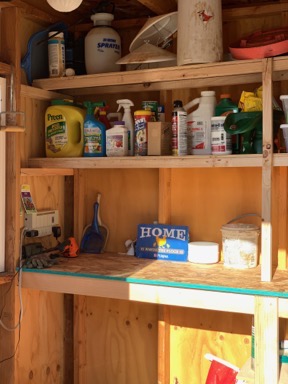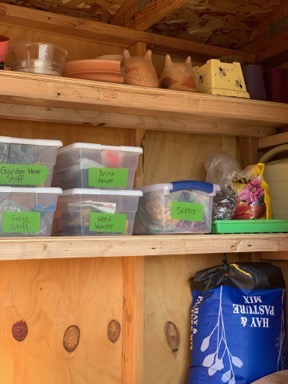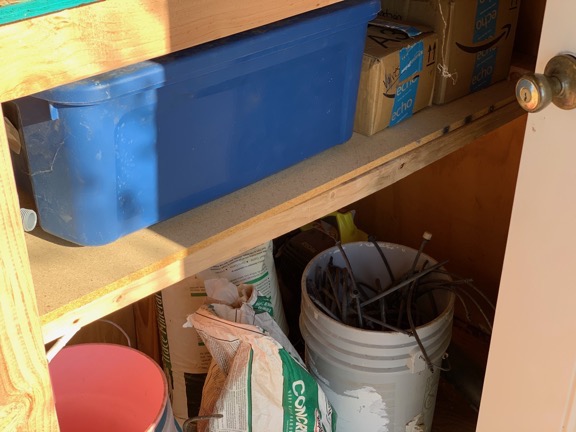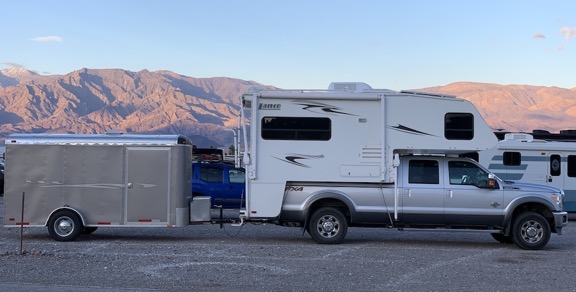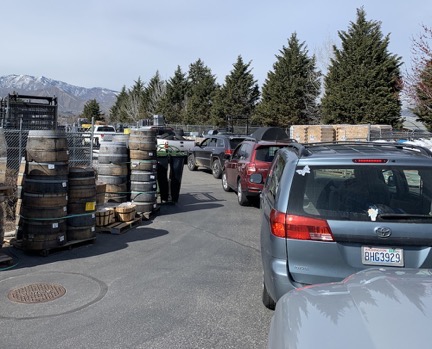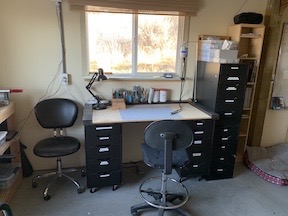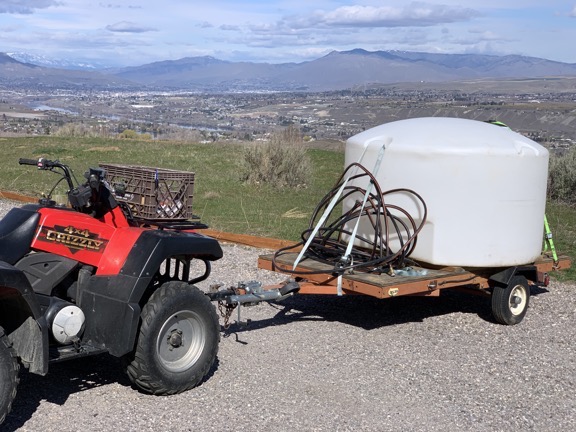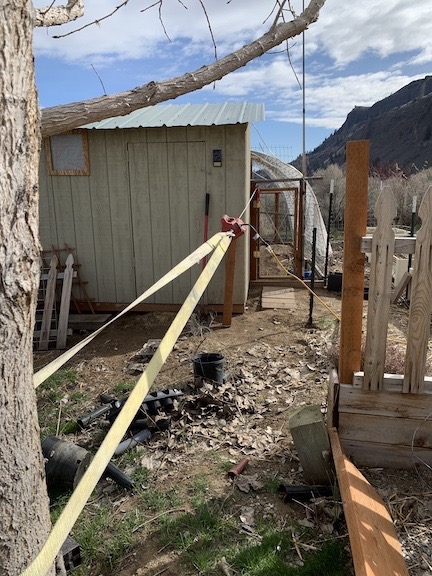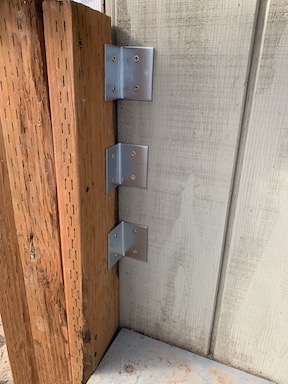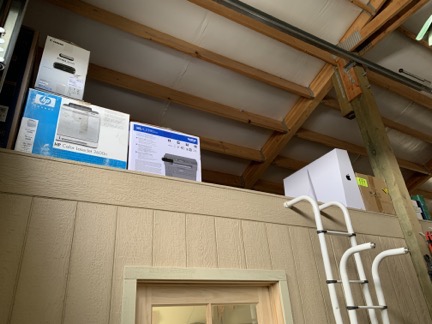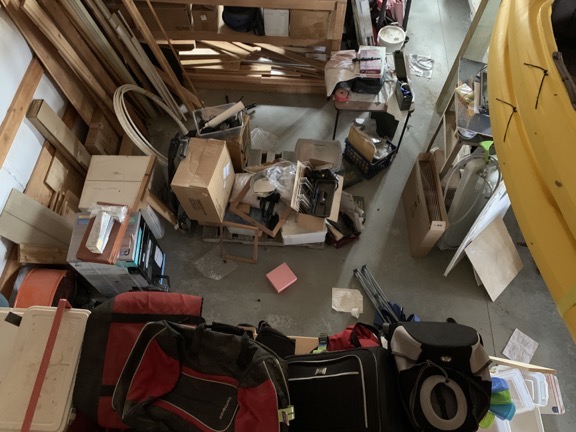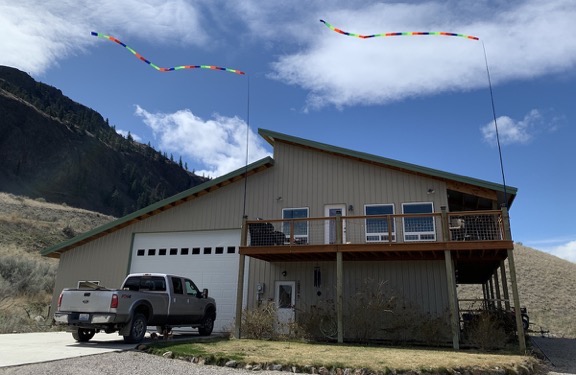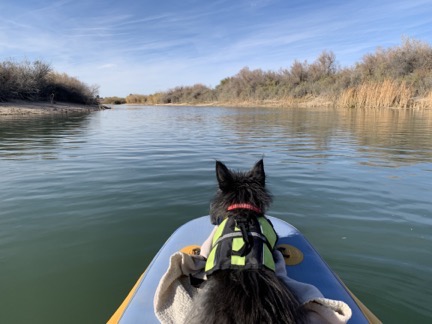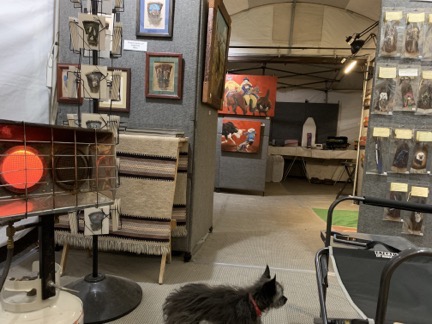Not such a hardship if you already have hermit-like tendencies.
I got back from my winter travels on March 16 — just two weeks ago? — just in time for the U.S. to finally start getting serious about coronavirus. That’s right around the time they closed restaurants in Washington state for anything other than takeout or drive-up windows.

My rig in a “campground” in Death Valley on the second day of my drive home. The park was remarkably crowded, considering the virus situation was starting to cause closures.
Venturing Out

I’ve never waited behind more than two cars to pick up feed at Coastal; that Tuesday I waited behind eight cars.
Since I’d been on the road in mostly rural or remote areas for the previous two weeks, I honestly didn’t know what to expect when I got home, so I placed a grocery order for pickup on Tuesday. While out, I was able to get my dogs’ nails trimmed at the local pet grooming place, pick up an order of Thai food to go, and stop off at the feed store for chicken feed. Everything looked pretty normal except there was an outrageously long line to pick up my chicken feed.
I went for groceries in person the following Sunday, mostly because Fred Meyer (my grocery store of choice) had a three day wait for pickup orders and, during the three days you were waiting, items that became out of stock would fall off your purchase. You’d wind up with half of what you needed — a situation that was patently absurd if they expected people to stay home. I chose Sunday morning for my visit and was pleasantly surprised by a nearly empty parking lot and store and relatively well-stocked shelves. Indeed, the only thing on my list that I couldn’t get was Jimmy Dean sausage, which I happen to like with my breakfast. I bought bacon instead. Not exactly a hardship.
I should mention that toilet paper was not a concern at my house. I have a lot of storage in my garage and I hate picking up non-perishable items like paper goods so I tend to buy in quantity. I had 20 rolls at home — for one person, mind you — and I later discovered that the toilet paper calculator says that’s enough for at least 100 days. It doesn’t matter because the supermarket had toilet paper. I didn’t buy any but everyone else visiting the store around the time I was there did. What’s up with that?
I ventured out again on Tuesday when it looked like things were on the verge of locking down more tightly. I’d placed an order for lumber at Lowe’s and needed to pick it up. (I’m building an 8 x 8 x 2 foot shelf in my garage to finish organizing the stuff I’ve accumulated so I can set up a wood shop.) I was actually on my way to Lowe’s when I heard about the stay-at-home order issued by the governor the night before. (Oops.) Picking up my lumber required only a brief stop at the Pro Desk right inside the door, so I was able to minimize my contact with anyone. I stopped at the local Ace hardware store — Stan’s Merry Mart — to pick up eight 2 cf bags of garden soil and one 3 cf bag of peat moss, then headed home. I had enough stuff in the back of my truck to keep me busy for at least a week.
At Home
In the meantime, all the time I wasn’t heading out to shop for stuff I needed, I was home working on projects. I always have projects to do at my home.
The unpacking
The first project was unpacking my camper and utility trailer after my winter travels and getting my jewelry shop back in order. This was actually a pretty big project since it required moving furniture. Every time I move furniture I vacuum around where things were and where things are going. This time I also washed the concrete floor. I had to move a rolling cabinet from the back of my garage to the front and then into my shop. It was a small miracle that I could do it since my garage is packed with not only my stuff but various boxed appliances and cabinets that I’m storing for a neighbor who is building a house. Fortunately, the cabinet was only 24 inches deep; if the dimensions were any bigger, I probably wouldn’t have been able to get it into place; there were some pretty tight squeezes along the way.
At this point, the jewelry end of my shop is pretty much ready to go but the general workshop on the other end of the 12 x 24 foot room needs some work.




Photos of my jewelry workshop: my new grinding/drilling station, my soldering station, my rolling mill/metal cutting station, and my main workbench.
The garden
Then, as the weather started to warm up, I went out into the garden and started work on that. My garden occupies a relatively small area between my chicken yard, driveway, and shed.
Although I’d built pallet planters years ago for raised garden beds, two years ago I began replacing them with far more practical plastic cherry bins. These 4 x 4 x 1 foot bins each hold about 300 pounds of cherries for transport to packing houses. In the old days, they were made out of wood and wooden ones are still in use. Now they’re made out of molded plastic, which is more sanitary and lasts longer. What makes them great for planters is that they’re off the ground and have drainage on the bottom and all sides. They’re expensive to buy, but a friend of mine, knowing that I was looking for them, found me a good deal on Craig’s List. A pot farm that had been using them as planters was going out of business. I bought 10 and added them to the two I already had managed to acquire.
Over the past two years, I’d been tearing out the wooden planters and replacing them with the bins. At the start of last spring, I had 10 in place and needed to pull one more. But last spring was interrupted by my two-week cruise up the inside passage to Alaska so I lost a lot of gardening time. By the time I returned, I discovered that hornets had already returned to the planter. Since I had plenty of other planters available, I let it go for the season. Near the end of the season, I pretty much saturated the wood with wasp/hornet spray and then ripped out the planter. Last week, I finally dragged one of the two remaining empties up from my bee yard, put it in place, and started filling it with soil and compost.

The eleventh cherry bin is now in place as a raised garden bed. I think I can squeeze one more into the garden, but it would require some reconfiguration near the shed, which is not a priority.

While I had my old bee trailer hooked up to my ATV, I figured I’d finally move the 425 gallon water transfer tank I’d had near my glamping tent. I wasn’t using it and was tired of looking at it out my window — as I’m sure my neighbors were. This setup made it very easy to move.
The compost

I got some nice compost from one of my two composter.
The compost came from one of my two composters — the rotating one. It was good compost with only a few remnants of its original ingredients. I distributed it among a handful of planters, along with fresh garden soil and peat moss. Over the course of a few days, I was able to plant onion sets and potatoes in two of the planters and get another three of the planters completely prepped for more crops. I noticed that my chives and rhubarb, perennials planted in round plastic pots were both coming back and the garlic that I’d planted in October in one of the other pots was sprouting nicely. I still haven’t seen the horseradish and I’m not sure what the story is there.
The other composter is a pile in an enclosure I’d made against one side of my chicken coop with — what else? — pallets. (I think I finally have the pallet thing out of my system.) That had a ton of yard waste in it, including grass clippings, leaves, and chicken manure. I’d added water faithfully throughout the previous summer and had done what I could to aerate it. But when I pulled the third side off to access the compost, I was faced with a pile of dried yard waste that didn’t resemble compost at all. I’d already decided that I wanted to get rid of that pile and replace it with a second rotating composter, so what was I going to do with all that waste? The answer was to throw it in the chicken yard so the chickens could scratch through it.
The chicken yard
Of course, my chicken yard needed a lot of work, too. Before I’d left in the late autumn, my chickens had started disappearing out of their coop at night. I could not figure out what was getting in or how it was doing it. I secured most of the openings large enough for a predator to get through and thought I had the problem licked. But about a week after I arrived in Arizona in December I got a text from a panicked house-sitter who had found a headless chicken in the coop. I hurriedly made arrangements for a friend who raises chickens to come get them and keep them for the winter. Now I needed to prep their enclosure for arrival.
My chicken coop is a 4 x 8 foot building with nests, a brooding area, and perches. The coop has two chicken-sized doorways leading out to two separate yards created by hooping welded metal fence panels between 2 x 4s laid out in a frame on the ground. One enclosure is 8 x 15 feet; the other is 8 x 10 feet. I can close off the doors to either enclosure and usually have the smaller enclosure blocked off during the winter months. The design, which I’d gotten from a neighbor’s setup, works remarkably well because it prevents aerial predators like eagles, hawks, and owls from getting in. In the winter, I have a reinforced clear plastic tarp that I can secure over it to keep most of the snow out so the chickens can still get out to eat and drink. Their coop has a heater that can usually keep the temperature above freezing.
The hooped enclosure has a frame that was originally up against the side of the coop. Over time, tthe coop and yard enclosure started to separate as either the building leaning away from the building. The gap was large enough for one of my barn cats to get through it — I actually saw him do it. It definitely needed to be closed up.

I put the strap around the tree, attached it to the winch, and attached the winch cable to the yard’s frame.
I thought about this problem long and hard and finally realized that I might be able to bring the frame back to its vertical position using the 1000 lb winch I had. So I rigged it up with a tow strap around a nearby tree and the winch cable around the frame. (If that tree wasn’t there, I was prepared to park my Jeep nearby and use that as an anchor, but the tree worked great.) Within a few minutes, I had the frame back up against the building. I then used a handful of metal brackets and screws and a bit of scrap wood inside the coop to secure the frame to the coop. Then I closed up any remaining gaps between the fencing and the building with chicken wire.


On the left, you can see that the gap is almost closed; I was able to get it very tight against the building. On the right are the three brackets I used to secure the frame to the chicken coop.
I also had some small gaps under the yard’s frame created by scratching chickens. Chickens, if left to their devices, will dig holes in the ground to look for bugs and to make dusting holes. Over the years, they’d dug holes under the frame in a few places. They weren’t big enough for chickens to get out, but they were definitely big enough for large rodents — like weasels, perhaps? — to get in. I closed up these holes by hauling buckets full of river rock left over from the installation of my septic system back in 2013. There’s a pile of this rock in my side yard that’s visible in the spring before grass and weeds and wildflowers hide it from view. I really need to clear it out and I put a big dent in it this week. (I added that failed compost after the rocks.)
And yes, I retrieved my chickens yesterday. I got my first egg from them that afternoon.
Other Projects
I have lots of other projects to do to keep me busy at home. I always do.

One of the bonuses of enclosing part of my garage to make a shop is that I gained a 12 x 24 foot storage loft above it. I’m using it now to store empty boxes I might need in the future.
The big project coming up is that shelf unit. I already have one just like it and although it’s easy to build, it isn’t easy to get it upright after I build it. I don’t think I can build it in an upright position, though. So that means clearing a space for it to occupy while it’s being built, building it, and then calling a friend over to help me lift it into place. It’s going to give me enough storage space to get any loose items currently on the floor on to a shelf, thus clearing out that floorspace.
I already have an old IKEA shelf unit in that area, but it’s getting moved out — likely to my shed, which is in dire need of reorganizing. Then I’ll move my miter saw and table saw into that newly cleared out 12 x 12 space and have a dedicated woodworking area. There’s nothing quite like having your tools out and easily accessible when you need to make a quick wood cut.

Here’s a view from above of the 12 x 12 foot area that will be my wood shop. It’s a total disaster. The shelves will go against the outside wall on the left in this shot. There’s already a short shelf at the top of this shot. The IKEA shelves are at the bottom in this shot and they’ll be moved out. The kayaks hang from the rafters and I can walk under them; the remainder of the big RV garage is to the right.
The shed is another big project. It was neat and organized once. Really. I swear. At this point, however, it needs everything removed from it, shelves moved and installed, and an against the wall “corral” for long-handled garden tools. At the same time, I want to put in shelves around the little window and install some plant lights so I can start seeds in there. I suspect, however, that I won’t get to that project until seed-starting season is over.
My bees need work, too. Right now, I don’t have any; although I’ve had up to 9 colonies at a time, they’ve been dying off each winter and, last year, I didn’t catch any swarms or buy any bees. I have two colonies on order now and will get them in April. In the meantime, I want to clear out my bee yard and possibly create a new, smaller yard nearer to my garden. This would mean cutting back a bunch of sagebrush and setting up a bench for the hives. I also want to go through all my beehive components and sell a bunch of them off. This is the season to do that, so I need to get on it soon.
And then I have more gardening to do. On this past Sunday’s trip to Fred Meyer — I go once a week now — I picked up some early vegetable starts and seeds. Although we’re expecting some cold weather over the next few days, I’m pretty sure I’ll be able to get the broccoli, brussels sprouts, and spinach into the ground before Friday. I might also plant carrots, scallions, beets, and radishes. And, of course, I still need to prep five planters and transplant my strawberries to a vertical planter I bought for them.
And have I mentioned the new bathroom under the stairs in the garage? That’ll need to wait until my neighbor who is building his house has time to frame it out for me. Then I’ll need to get a plumber over, buy fixtures, and set all that up. That likely won’t get started until much later this summer.
I have countless other small projects to take care of. Honestly, I’ve made living here a full-time job. Why? Well, why not? The alternative is to sit on my ass all day, like I did when I lived in Arizona.
And That’s the Point
That brings me around to the point of this blog post: staying at home during this virus outbreak isn’t much of a hardship for me. I have tons to do both inside and outside my home. I have most of the materials and tools I need to get the job done and, even if I don’t, my once-a-week trip to Fred Meyer — which has more than just food — should make it possible to stock up with what I need.
And yes, I still do socialize. I’m on Twitter entirely too much, chatting back and forth with friends there. I participated in a virtual fly-in with pilots from the UK, US, and Canada on Saturday. I text with numerous friends throughout each day. I talk on the phone with my sister and friends who don’t like to text. And every time I head into town, I pick up grocery items for a neighbor who has a compromised immune system. I even stopped to chat with two neighbors yesterday; I maintained a safe distance away whenever possible.
I’m not lonely; I don’t get lonely. You can’t get lonely when you keep busy and stay in touch with friends and family through other means.
So unlike so many folks who go out every day and spend more time away from home than at home, I’m not suffering at all.
I know I’m fortunate in many ways and I’m certainly not trying to rub that in. I’m just offering up an alternative look at what it’s like to stay at home.
I’m also hoping that those of you who aren’t always at home take away another message: use this opportunity to do things around your home to make your life better. Clean, organize, get rid of stuff you don’t want (or that doesn’t give you joy). If you have a yard or garden, get out there and do some springtime clean up or make some improvements. Look at that to-do list and knock off the things you’ve been wanting to get done. And if your access to the outdoors is limited because, perhaps, you live in an apartment, take this opportunity to catch up on reading or learn a new skill through books or videos. I can’t begin to tell you how much I’ve learned in the past week about gardening on YouTube.

The new wind ribbons I put on the front of my house give me lots of joy.
Don’t sit on your butt and spend your days eating and watching television. Make this time count, whether you live alone or with your family.
Yes, I know things can be rough for some folks — especially folks who have lost their jobs and are dealing with financial hardships — but things won’t get better if you dwell on the problems you’re facing. Do what you can to ease those financial problems and then try to make the best of a difficult situation. It’ll help the time pass more easily.
Good luck, stay safe, and do your part to make things better for everyone.







